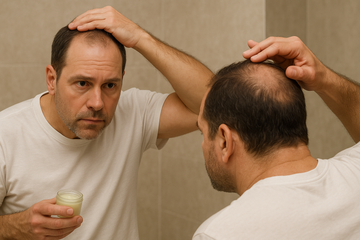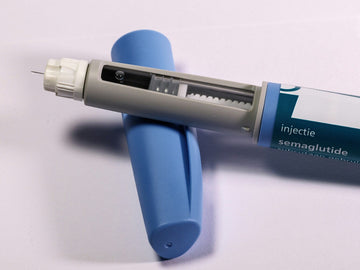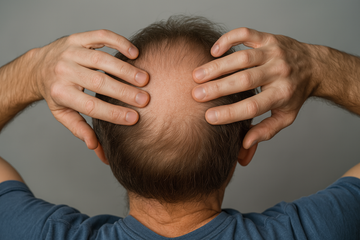Can Low Iron Cause Hair Loss?

Marinella Helera • Jul 07, 2025
Noticing more hair on your pillow or in the shower? This can feel worrying, especially if it starts happening all of a sudden. Many people assume that hair loss is caused by aging, stress, genetics, or other hair conditions, such as male-pattern baldness. However, there's another reason that's often overlooked, and that's low iron levels.
Iron helps your body move oxygen through the blood. This includes the oxygen needed by your hair roots to grow strong, healthy strands. In the case of iron deficiency anemia, your hair may stop growing as it should and start falling out more than usual. This is called telogen effluvium.
Doctors usually don't suspect it unless there are other clear signs. However, men can become iron deficient from stomach issues, frequent blood donation, or slow internal bleeding.
This blog covers the symptoms of low iron, how it's diagnosed, what treatments are available, and answers the question: Can low iron cause hair loss?
Can Low Iron Really Cause Hair Loss?
Yes, low iron can lead to hair loss. This is a well-documented medical fact, not just an occasional finding. Iron supports several essential functions in the body, and hair growth is one of them. The connection between iron deficiency and hair loss is often overlooked, but it is crucial, especially when other potential causes have been ruled out.
Iron helps your body make hemoglobin, which is the part of red blood cells that carries oxygen to tissues and organs. Your hair follicles rely on oxygen to stay active and grow hair. Low iron levels can limit the body's ability to supply oxygen. When this happens, your body prioritizes vital organs, which means your hair gets less support. As a result, hair follicles may stop growing and enter a resting phase, causing increased hair loss over time.
Ferritin is another key part of this picture. It is the protein that stores iron in your body. Even if your overall iron levels appear normal, low ferritin levels can still impact your hair. This makes ferritin a more useful marker when investigating unexplained hair loss.
Hair loss from low iron is usually not permanent, but it can last for a long time if not addressed. The pattern is one of general thinning across the scalp, rather than patchy bald spots.
Why Men Might Overlook Iron Deficiency
Iron deficiency is often perceived as a condition that primarily affects women. This is because women lose iron through their menstrual cycle, making it a more common topic in women's health. Over time, this idea has led to the perception that men do not need to worry about low iron levels. However, men can also experience iron deficiency, and it often remains unnoticed, including signs like fatigue or iron deficiency hair loss.
Recent data from the CDC indicate that approximately 5.5% of males aged two and older have anemia. The overall anemia rate among adults is 9.3%, but nearly half of these cases are found in men despite a lower prevalence overall. These numbers highlight that men are not immune.
Men may become iron-deficient for various reasons. Stomach issues, such as ulcers or inflammation, can cause slow blood loss that gradually lowers iron levels over time. Some men do not eat enough iron-rich foods, especially if they follow restrictive diets. Intense exercise, such as long-distance running, may also lower iron levels through small amounts of internal bleeding or increased iron demand. Additionally, frequent blood donation is another factor that can reduce iron stores.
Signs of Low Iron & Hair Loss in Men
Iron deficiency can appear in different ways, and the symptoms are not always apparent at first. Many men may not realize they have low iron until the signs become more noticeable. Early symptoms often feel general, which makes it easy to mistake them for stress, aging, or poor sleep. Fatigue is one of the most common early signs, as it can leave you feeling tired, even after a full night of rest. You may also notice that your skin appears paler than usual or that you feel dizzy when standing up too quickly.
Some men report trouble focusing or feeling short of breath during mild activity. These symptoms happen because your body is not getting enough oxygen due to lower red blood cell production. Iron is needed to make hemoglobin, the part of red blood cells that carries oxygen.
Hair-related signs usually follow after these early changes. One of the first things men notice is more hair on their pillow, in the shower, or on their brush. Some also see hair thinning at the temples or on the crown of the head. This type of hair loss is not patchy like bald spots. Instead, it appears to be a slow, overall thinning. The texture of your hair might also change, and hair can feel drier or weaker than before. These changes happen when hair follicles do not receive enough oxygen and nutrients.
|
Symptom |
Description |
|
Fatigue |
Constant tiredness, even after rest |
|
Pale skin |
Skin looks lighter, especially on the face |
|
Dizziness |
Light-headedness or faint feeling |
|
Shortness of breath |
Especially during mild physical activity |
|
Cold hands and feet |
Reduced blood flow due to low hemoglobin |
|
Increased hair shedding |
More hair seen in the brush, shower, or on the pillow |
|
Thinning hair |
Gradual loss, especially at temples or the crown |
|
Dry or brittle hair |
Hair feels weaker, breaks more easily |
Ferritin Levels: An Important Hair Health Marker
Ferritin is a protein that stores iron and releases it when the body needs it. It holds extra iron and releases it when needed. While most people focus on hemoglobin to check iron levels, ferritin provides a clearer picture of the amount of usable iron your body has. This is important for many functions, including hair growth.
Hair follicles need oxygen and nutrients to stay active. Iron helps carry oxygen through the blood. When ferritin levels are low, your body redirects iron to more vital organs, such as the heart or brain. Hair becomes a lower priority. As a result, follicles stop growing new hair and enter a resting phase. This leads to more shedding and slower regrowth.
Ferritin levels should be above 50 nanograms per milliliter (ng/mL) to support hair growth. Levels below that can affect the hair growth cycle, even if hemoglobin levels appear normal. In some cases, doctors recommend aiming for levels closer to 70 ng/mL, especially when hair loss is ongoing.
Men experiencing unexplained hair thinning, especially in conjunction with fatigue or other symptoms of iron deficiency, may benefit from checking their ferritin levels. Many standard iron panels do not include it unless specifically requested.
|
Ferritin Level (ng/mL) |
Impact on Hair Growth |
|
Below 20 |
High risk of hair shedding |
|
20 – 49 |
Possible impact on hair density |
|
50 – 70 |
Supports stable hair growth |
|
Above 70 |
Optimal range for hair health |
Diagnosing Iron Deficiency: What to Ask Your Doctor
If you are experiencing sudden hair loss, low energy, or other changes in your health, consult a doctor to check your iron levels. Many symptoms of iron deficiency are easy to miss or may be mistaken for stress, lack of sleep, or aging. Blood tests are the most accurate way to know what is happening inside your body.
During your visit, your doctor can order the following blood tests.
-
Complete Blood Count (CBC)
This test looks at the overall health of your red blood cells. It can detect anemia and indicate if your red blood cells are smaller or fewer in number than normal.
-
Ferritin
Ferritin measures how much iron is stored in your body. This is one of the most useful tests when hair loss is a concern. Low ferritin levels can exist even if other iron levels appear normal.
-
Hemoglobin
Hemoglobin indicates how effectively your red blood cells transport oxygen. Low hemoglobin is often used to confirm anemia.
-
Serum Iron
This test evaluates the amount of iron circulating in your blood at the time of the test.
-
Total Iron Binding Capacity (TIBC)
This helps doctors assess how well your body can absorb and utilize iron.
Clearly describe all your symptoms during your appointment so your doctor can select the appropriate tests. If hair loss is sudden or followed by symptoms such as fatigue, cold hands, or pale skin, be sure to mention this. You can also request a ferritin test directly, as it may not be included by default. Early testing can lead to simple steps that improve both energy and hair health.
How to Restore Iron and Promote Hair Growth
You can raise your iron levels to support hair regrowth, but the process takes time and steady habits. You can begin by making changes to your diet, adding supplements if needed, and following a few simple lifestyle steps that help your body utilize iron more effectively.
Start with iron-rich foods. Eating the proper meals every day can help gradually increase your iron levels. Red meat, such as beef and lamb, is a strong source of iron that your body absorbs easily. Consume plant foods like spinach, lentils, tofu, and pumpkin seeds. To absorb more of these nutrients, eat them with fruits or vegetables that are high in vitamin C, such as oranges, bell peppers, or tomatoes.
Additionally, supplements may also be beneficial, but only if your doctor recommends them. Iron tablets are often prescribed when blood tests indicate low iron levels. Vitamin C taken with iron helps your body absorb it better.
You must also adjust your eating and drinking habits around meals. Try to avoid drinking coffee or tea right before or after eating, as they can interfere with iron absorption. Additionally, avoid taking iron with calcium, as it can slow down the absorption of both. Do not take iron pills on your own without a test, as excessive iron can be harmful to your body.
|
Timeframe |
What You May Notice |
|
0–1 Month |
Slight boost in energy |
|
1–2 Months |
Less hair falling in the shower or on the pillow |
|
3–4 Months |
Fine new hair in thinning spots |
|
5–6 Months |
Hair begins to feel thicker and healthier |
|
6+ Months |
Fuller, stronger growth continues |
When Hair Grows Back – and When to Seek Help
Hair often starts to grow back within three to six months after taking steps for iron deficiency. Many people first notice less hair fall by the second month. New growth may appear as soft, fine hair in areas that have thinned. By six months, the hair may feel thicker and look fuller. But this timeline is not the same for everyone. Some people may require more time, depending on how low their iron levels are and how their body responds.
At the same time, iron is not the only reason people lose hair. Hormonal changes like high DHT, ongoing stress, certain medications, or scalp problems can also cause thinning. Therefore, if hair does not improve after several months, it may be a sign that something else is occurring.
In that case, it's a good idea to consult with a specialist. A trichologist or dermatologist can help identify other potential causes and guide the next steps.
Support Hair Recovery with Spartan Products for Men
Can iron deficiency cause hair loss? Yes, it can. While your body works on building up iron levels, using the right hair products can support hair from the outside. Simple steps, such as washing and conditioning with specially formulated products, can help your scalp and hair stay healthy during recovery.
Spartan offers two products that are easy to add to your routine.
- The Root Activator Shampoo cleans the scalp and removes buildup. A clean scalp allows nutrients to reach hair roots more easily. This shampoo is made to support men who are noticing hair thinning or slow regrowth. This type of external care is beneficial when managing low iron levels.
- The Root Activator Conditioner works alongside the shampoo. It helps make hair softer and reduces breakage. It also supports the strength of each strand, which is useful when hair is already weak or thinning.
These products are not a treatment for low iron. However, they can support scalp health and provide hair with the care it needs during regrowth.









